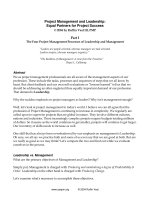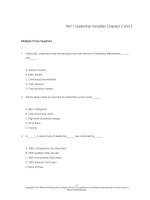Lecture Art of Leadership and Motivation - Lecture 19
Bạn đang xem bản rút gọn của tài liệu. Xem và tải ngay bản đầy đủ của tài liệu tại đây (832.12 KB, 40 trang )
Art of Leadership & Motivation
HRM – 760
Lecture 19
FACILITATOR
Prof. Dr. Mohammad Majid Mahmood
Leadership Behavior, Motivation, &
Leadership Theories
2
Leader Behaviors
Leader behavior vary depending on
subordinates and situations.
3
Leader Behaviors
• Directive leadership.
– Task-oriented, expectations, techniques,
timeline, standards of performance.
• Supportive leadership.
– Friendliness, approachability, understanding,
needs-oriented, equality, respect.
4
Leader Behaviors
• Participative leadership.
– Sharing, consultation, advice-seeking,
integration.
• Achievement-oriented leadership.
– Challenging, high standard of excellence,
confidence in subordinates’ abilities.
5
Self Motivation
• Do it now
• Break up the task into small steps
• Don’t wait for mood
• Start action
• Solutions will follow if you try
6
Making Your Vision Reality
What will you need to do to achieve your 510 year`s vision?
What’s a must?
What’s useful?
What’s good, but not vital
7
What Makes YOU Unique?
8
The 21st Century Success
Factors
Get Noticed
Be Remembered
Make a Name for Yourself
9
What makes you
stand out?
•
•
•
•
•
What do you love doing?
What comes easy?
What is important to you?
What do others appreciate about you?
What are your greatest strengths?
10
Intrinsic vs. Extrinsic Rewards
Extrinsic = Outside
Recognition
Promotions
Gifts
11
Intrinsic = Inside
Feeling of Job
Well Done
Pride
Sense of
Achievement
Praise
Salary
Increase
Status
Leadership Theories
Trait
Behavioral
Contingency
Transformational
12
Trait Theory
Initial leadership research (1920-30’s)
Focused on “what” an effective leader is,
not on “how” to effectively lead.
Assumes that certain physical, social
and personal traits are inherent in
leaders.
13
Trait Theories
Early trait theories identified:
Physical characteristics (height,
appearance)
Personality characteristics (extrovert)
Skills and abilities (intelligence)
Social factors (interpersonal skills)
14
Trait Theory - Limitations
No consistent application of traits and
leadership effectiveness
Tries to relate physical characteristics to
effective leadership
Leadership is too complex to explain
with such a simple model
15
Behavioral Theories
The behavior approach focuses on the
behaviors that effective leaders engage
in.
16
Behavioral Theories
People could be trained to be leaders.
Developed training programs to
influence leadership behavior.
Assumed that the best styles of
leadership could be learned.
17
Contingency Theories
Successful leaders are able to identify
clues in an environment and adapt their
leadership style to the situation.
Environment influences the type of
leadership needed.
Examples:
1) Fiedler’s Contingency Model
2) Path-Goal Theory
3) Vroom-Yetton Model
18
Fiedler’s Contingency Theory
The theory that leader effectiveness is determined by both
the personal characteristics of leaders and by the situation
in which leaders find themselves.
Sheds light on FOLLOWING important issues:
Why, in a particular situation, some leaders will be effective
and other leaders with equally good credentials will be
ineffective.
Why a particular leader may be effective in one situation but
not in another.
There is no best way for leaders to lead.
19
Path-Goal Theory of
Leadership
Path-Goal Theory of Leadership
formulated by Robert House
proposes that the leader can
affect the performance,
satisfaction, and motivation of a
group in different ways:
Offering rewards for
achieving performance
goals
Clarifying paths towards
these goals
Removing obstacles to
performance
20
Path-Goal Theory of Leadership
Leader’s job is viewed as coaching or guiding
workers to choose the best paths for reaching
goals:
Achievement-oriented leadership – leader set
challenging goals and encourages followers to
achieve (appropriate to use when followers suffers
from lack of job challenge).
Directive leadership – leader let followers know
what is expected and tells them how to perform
their task (appropriate to use when followers have
ambiguous jobs)
21
Path-Goal Theory of
Leadership
Participative leadership – leaders consult with
followers and ask for suggestions before making
a decision (appropriate to use when follower is
using improper procedures or making poor
decisions).
Supportive leadership – leader is friendly,
approachable and shows concern for followers’
psychological well being (appropriate when the
follower lacks confidence).
22
Vroom and Yetton Model
A model that describes the different styles
in which leaders can make decisions.
DecisionMaking Styles:
Autocratic (A) The leader makes the decision without
input from subordinates.
Consultative (C) Subordinates have some input, but the
leader makes the decision.
Group (G) The group makes the decision; the leader is
just another group member.
Delegated (D) The leader gives exclusive responsibility
to subordinates.
23
Leadership Models
Charismatic Leadership
Situational Leadership
Transformational Leadership
24
Weber’s Charismatic
Leadership
• Influence based on
follower perceptions
that the leader is
endowed with the
gift of divine
inspiration or
supernatural
qualities.
25
93









